
A land mine, or landmine, is an explosive weapon concealed under or camouflaged on the ground, and designed to destroy or disable enemy targets, ranging from combatants to vehicles and tanks, as they pass over or near it.

The Algerian People's National Army is the military force of Algeria. It is the direct successor of the National Liberation Army (ALN), the armed wing of the nationalist National Liberation Front, which fought French colonial rule during the Algerian War of Independence (1954-1962).
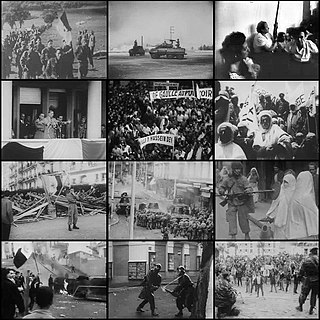
The Algerian War was a major armed conflict between France and the Algerian National Liberation Front (FLN) from 1954 to 1962, which led to Algeria winning its independence from France. An important decolonization war, it was a complex conflict characterized by guerrilla warfare and war crimes. The conflict also became a civil war between the different communities and within the communities. The war took place mainly on the territory of Algeria, with repercussions in metropolitan France.

Unexploded ordnance, unexploded bombs (UXBs), and explosive remnants of war are explosive weapons that did not explode when they were employed and still pose a risk of detonation, sometimes many decades after they were used or discarded. When unwanted munitions are found, they are sometimes destroyed in controlled explosions, but accidental detonation of even very old explosives also occurs, sometimes with fatal results. A dud is an unexploded projectile fired in anger against an enemy, but which has failed to explode. A projectile not fired in anger but which has failed to explode is called a 'blind'.

The Convention on the Prohibition of the Use, Stockpiling, Production and Transfer of Anti-Personnel Mines and on their Destruction of 1997, known informally as the Ottawa Treaty, the Anti-Personnel Mine Ban Convention, or often simply the Mine Ban Treaty, aims at eliminating anti-personnel landmines (APLs) around the world.

The Moroccan Western Sahara Wall or the Berm, also called the Moroccan sand wall, is an approximately 2,700 km-long (1,700 mi) berm running south to north through Western Sahara and the southwestern portion of Morocco. It separates the Moroccan-controlled areas on the west from the Polisario-controlled areas on the east. The main function of the barriers is to exclude guerrilla fighters of the Polisario Front, who have sought Western Saharan independence since before Spain ended its colonial occupation in 1975, from the Moroccan-controlled western part of the territory.

PFM-1 is a scatterable high explosive anti-personnel land mine of Soviet and Russian production. It is also known as a Green Parrot or Butterfly Mine. The mines can be deployed from mortars, helicopters and aeroplanes in large numbers; they glide to the ground without exploding and will explode later upon contact.
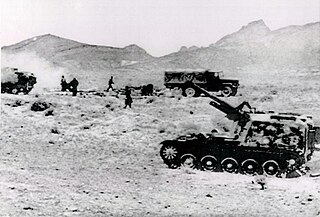
The Sand War was a border conflict between Algeria and Morocco fought from September 25 to October 30, 1963, although a formal peace treaty was not signed until February 20, 1964. It resulted largely from the Moroccan government's claim to portions of Algeria's Tindouf and Béchar provinces. The Sand War led to heightened tensions between the two countries for several decades.
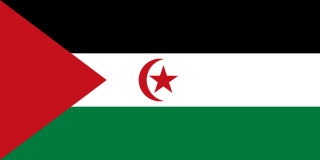
The Sahrawi People's Liberation Army is the army of the Sahrawi Arab Democratic Republic (SADR) and previously served as the armed wing of the Polisario Front prior to the foundation of the Republic. Its commander-in-chief was the Secretary General of the Polisario, but the army is now also integrated into the SADR government through the SADR Minister of Defence. The SADR and the Polisario Front have no navy or air force. The SPLA's armed units are considered to have a manpower of possibly 20,000–30,000 active soldiers today, but during the war years its strength appears to have increased to 100,000 men. It has a potential manpower of many times that number, since both male and female refugees in the Tindouf camps undergo military training at age 18. Women formed auxiliary units protecting the camps during war years.
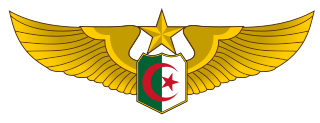
The Algerian Air Force (AAF) is the aerial arm of the Algerian People's National Army.

An Islamist insurgency is taking place in the Maghreb region of North Africa, followed on from the end of the Algerian Civil War in 2002. The Algerian militant group Salafist Group for Preaching and Combat (GSPC) allied itself with al-Qaeda to eventually become al-Qaeda in the Islamic Maghreb (AQIM). The Algerian and other Maghreb governments fighting the militants have worked with the United States and the United Kingdom since 2007, when Operation Enduring Freedom – Trans Sahara began.
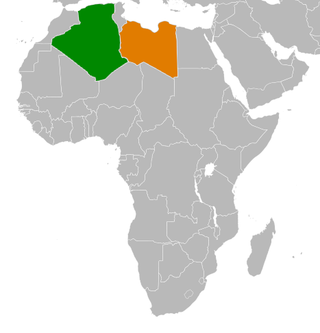
Relations between Algeria and Libya are considerably strained by tensions between the revolutionary National Transitional Council (NTC) of Libya and the single-party autocracy of President Abdelaziz Bouteflika of Algeria. Bilateral relations were generally amicable during Muammar Gaddafi's 42-year rule of Libya.
This article discusses the problem represented by land mines in North Africa, the consequent suffering of its peoples, and how the countries in the region deal with this problem.
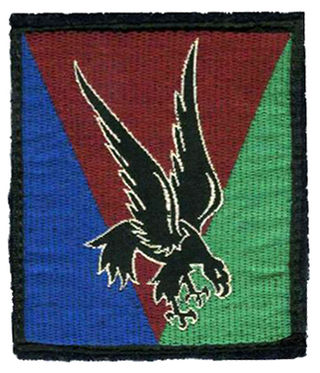
The 10th Parachute Division was a formation of the French Army, part of the French Airborne Units. It consisted predominantly of infantry troops, and specialized in airborne combat and air assault. Established in 1956, it fought primarily in the Suez Crisis and the Algerian War. It was dissolved immediately after the Algiers putsch of 1961.

Prak Sokhonn is a Cambodian politician, diplomat and journalist who currently serves as a member and first vice president of the Senate. He previously served in the Cabinet of Cambodia as Minister of Foreign Affairs of Cambodia from 2016 to 2023 and Deputy Prime Minister from 2018 to 2023.

Djelloul Khatib alias commandant Djelloul was a combatant for the Algerian independence and a public servant. During the war of independence he led the efforts towards the professionalization of the National Liberation Army (NLA). He contributed thereafter to building the civil service of newly independent Algeria.

There were approximately 30,000 land mines laid in British overseas territory of the Falkland Islands by Argentinian forces following their 1982 invasion. Some of the mines were cleared immediately following the successful British operation to retake the islands, but following a series of accidents, demining operations ceased. In the following years the mine fields were fenced off and, with human access limited, became havens for Falklands flora and the native penguin population. The British government ratified the Ottawa Treaty in 1998 that required the removal of all mines within its territory. Demining operations, which had to be carried out by hand due to the climate and local condition, restarted in 2009. The last mines were cleared in November 2020.

The 2019–2021 Algerian protests, also called Revolution of Smiles or Hirak Movement began on 16 February 2019, six days after Abdelaziz Bouteflika announced his candidacy for a fifth presidential term in a signed statement. These protests, without precedent since the Algerian Civil War, were peaceful and led the military to insist on Bouteflika's immediate resignation, which took place on 2 April 2019. By early May, a significant number of power-brokers close to the deposed administration, including the former president's younger brother Saïd, had been arrested.
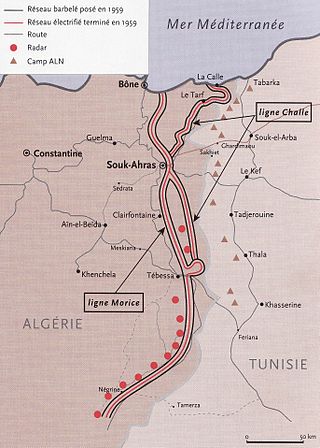
The battle of the borders, was a group of military operations initiated mainly on the Algeria-Tunisia border during the Algerian war, from 21 January to 28 May 1958, by the paratrooper units of the French army against the attacks, and bombardments of the Morice line by the combatants of the Armée de libération nationale (ALN), the military branch of the FLN, stationed in Tunisia.

Ukraine globally ranks as one of the states with the highest civilian casualties from landmines and unexploded ordnances, and the highest for anti-vehicle mine incidents. As of April 2023, it is estimated that approximately 174,000 square kilometers of Ukrainian territory are contaminated by landmines. Many types of landmines have been found in use in Ukraine, including novel variants. Though landmines have been in use since 2014 in Ukraine during the War in Donbas (2014–2022), their use was relatively sporadic until the Russian invasion of Ukraine. According to Human Rights Watch, both Russian and Ukrainian government forces have utilized antipersonnel and anti-vehicle mines.



















